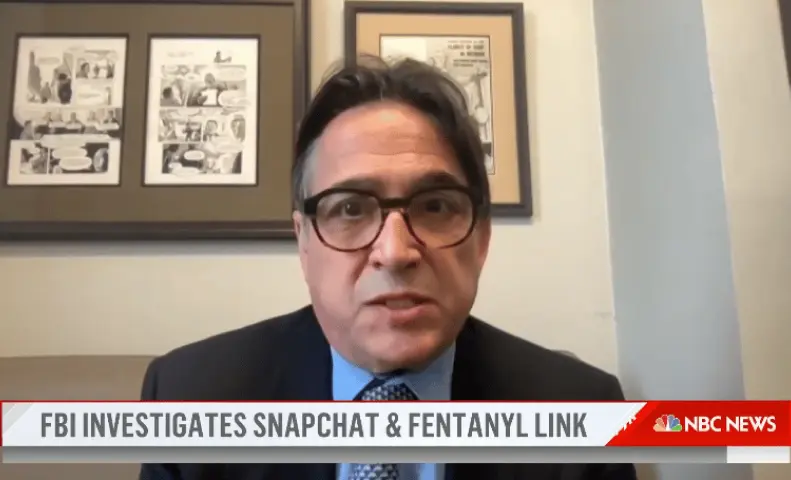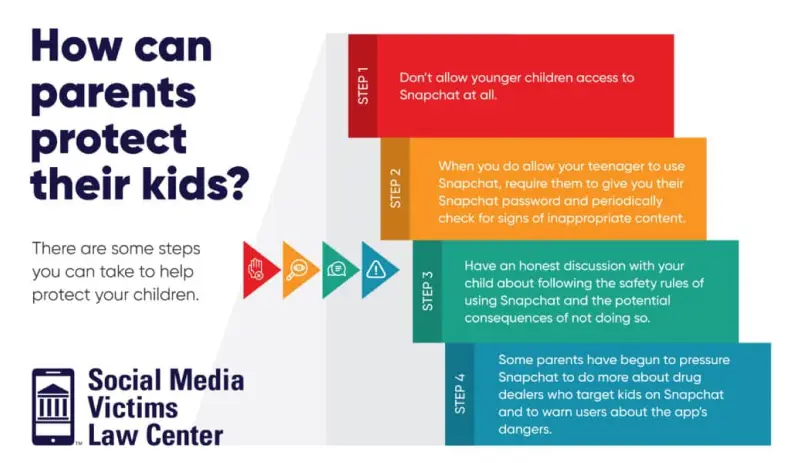Snapchat Fentanyl Lawsuit
The California Court of Appeals on Thursday, December 5, 2024 rejected Snap Inc.’s request to prevent parents from moving forward on their lawsuits to hold Snap accountable for the fentanyl poisoning their children sustained from counterfeit prescription drugs purchased on Snapchat.
 Written and edited by our team of expert legal content writers and reviewed and approved by Attorney Matthew Bergman
Written and edited by our team of expert legal content writers and reviewed and approved by Attorney Matthew Bergman
- Content last updated on:
- June 25, 2025
Written and edited by our team of expert legal content writers and reviewed and approved by

- Content last updated on:
- June 25, 2025
- How are kids coming into contact with fentanyl through Snapchat?
- Is Snapchat under federal investigation?
- How has Snapchat’s lack of regulation and responsibility contributed to fentanyl deaths?
- Snapchat’s response to the fentanyl lawsuits
- What is Section 230, and how is Snapchat trying to use it?
- How can parents protect their kids?
- What legal action is available to families impacted by a fentanyl death?
- How are kids coming into contact with fentanyl through Snapchat?
- Is Snapchat under federal investigation?
- How has Snapchat’s lack of regulation and responsibility contributed to fentanyl deaths?
- Snapchat’s response to the fentanyl lawsuits
- What is Section 230, and how is Snapchat trying to use it?
- How can parents protect their kids?
- What legal action is available to families impacted by a fentanyl death?

FOUNDING ATTORNEY
“This ruling marks the first time a court has allowed parents to hold social media companies accountable for facilitating the sale of deadly drugs. Fentanyl is the largest killer of kids under 18, and social media plays a huge role in the deadly drug sales that have resulted in a 350% increase in teen deaths over the past three years. Parents who lost children to fentanyl poisoning will now be able to move forward with lawsuits, uncover evidence of Snapchat’s contribution to illegal drug sales, and by holding Snap legally accountable spare other families the unspeakable grief they experience every day.”
In late 2022, the Social Media Victims Law Center (SMVLC) and C.A. Goldberg PLLC filed claims in Los Angeles Superior Court on behalf of Plaintiff parents alleging that Snapchat’s unique design features has created a vast online drug market for the sale of contaminated drugs that contributed to the 350% increase in fentanyl poisoning deaths among minors over the past three years. The Plaintiffs allege that Snapchat’s design encourages dealers to promote the sale of deadly drugs on a massive scale with little scrutiny from law enforcement and affirmatively connects predatory drug dealers with vulnerable teenagers who are not seeking to purchase drugs.
Snap immediately filed a demurrer, seeking to dismiss on the ground that because the Plaintiffs’ children were injured through third-party content that drug dealers posted on Snapchat, Snap was immune from suit under Section 230 of the Communications Decency Act. In a detailed written opinion of January 2, 2024, Superior Court Judge Lawrence P. Riff rejected Snap’s argument on the ground that the Plaintiffs’ product liability claims were not based on third-party content for which Snap is immune, but rather on Snapchat’s unreasonably dangerous design that facilitates the sale of illegal drugs and for Snap’s knowing failure to undertake reasonable efforts to curtail deadly drug sales on its platform. In March 2024, Snap sought discretionary review of Judge Riff’s ruling from the California Court of Appeals which stayed the underlying proceeding while the appeal was being considered.
On Thursday, December 5, 2024, the Court of Appeals denied Snap’s petition for discretionary review, permitting the Plaintiffs to resume their cases. This holding does not preclude Snap from asserting its Section 230 immunity defenses, but simply permits the Plaintiffs to move forward with discovery, review internal company documents, take sworn testimony from Snap personnel, and learn what the company knew about the sale of fentanyl-contaminated drugs on Snapchat, when the company knew about it, and why Snap allows these deadly sales to continue.

FOUNDING ATTORNEY
“The Court of Appeals has not ruled on the merits of parents’ claims, but simply given them the opportunity to try to make their case, and for this we are grateful.”
The initial lawsuit filed at the time represented the families of more than 60 teenagers and young adults who overdosed on fentanyl they accessed through Snapchat. Since this initial filing, more families have come forward to seek justice for their children.
If a Snapchat fentanyl death has impacted you or someone you know, contact Social Media Victims Law Center today to better understand your legal options.
How are kids coming into contact with fentanyl through Snapchat?
The Snapchat fentanyl lawsuit alleges the app’s unique features make it difficult for parents to police the content their children are viewing and simple for drug dealers to find young people online. Through the use of Snap Map, which pinpoints a user’s geographical location, drug dealers have instant access to thousands of young people in their communities, allowing them to target potential customers. As a result, drugs have become increasingly easy for kids to access, purchase, and have delivered straight to their front doors.
Counterfeit drugs on Snapchat
In nearly all Snapchat fentanyl deaths, the victim believed they were buying Oxycontin, Percocet, Xanax, or some other prescription drug from a dealer they connected with through the app. The fake pills they received actually contained lethal doses of fentanyl, which is readily available online since it’s cheap and easy to manufacture.
Is Snapchat under federal investigation?
As the fentanyl crisis reaches epidemic proportions, Snapchat has gained the attention of the Federal Bureau of Investigation. The agency is now examining Snapchat’s role in fentanyl poisoning deaths and whether the social media platform has helped to distribute fentanyl-laced pills across the country. The FBI is also demanding better cooperation with law enforcement when it comes to cracking down on fentanyl dealers who use Snapchat to conduct business.

How dangerous is fentanyl?
The Center for Disease Control and Prevention (CDC) published statistics from 2021 that show that 75 percent of drug overdose deaths in the United States that year were caused by opioid use, including illicitly made fentanyl, a synthetic opioid. Sometimes, a single counterfeit pill contains enough fentanyl to kill four people.
How has Snapchat's lack of regulation and responsibility contributed to fentanyl deaths?
Kids and teenagers are especially drawn to Snapchat because the app’s design prevents adults from monitoring or viewing content after it’s been read. Disappearing messages and the My Eyes Only function allow users to create time limits on Snaps so that they will disappear immediately after being opened and hide content they don’t want to share. Many critics say these features encourage bullying and illegal behavior and prevent parents from monitoring their child’s activities on the app.
Snapchat also uses an algorithm that feeds its users content based on their interests and previous interactions with the app. Content is organized by its relevance to the person viewing it. This continual reward system can lead to compulsive and addictive behaviors in young people.
Because the company’s business model relies on keeping users clicking, there is little incentive to monitor or remove harmful content frequently sought out by adolescents who are drawn to it. A significant criticism of Snapchat includes its use of monetized content without any regard for safety measures, making it an ideal place for drug dealers to do business out of sight of law enforcement.
Why do drug dealers choose Snapchat?
Unlike Instagram and TikTok, Snapchat provides privacy between parties as they communicate. Drug dealers can erase any evidence of communication and avoid responsibility when things go wrong.
Snapchat's response to the fentanyl lawsuits
Although Snapchat’s community guidelines prohibit the sale, exchange, or promotion of illegal or regulated drugs, there has been little evidence that the company has done much to curb drug sales on the app. Until now, social media companies have shielded themselves from any responsibility by citing a law written in 1996, well before the rise of social media.
What is Section 230, and how is Snapchat trying to use it?
Section 230 of the Communications Decency Act allowed companies at the advent of the Internet to provide user content without liability for that content as long as they didn’t edit or restrict it in any way. Section 230 is often promoted under the guise of free speech, and Snapchat argues that it isn’t liable for fentanyl deaths because it doesn’t attempt to moderate the content its users post.
Unfortunately, this lack of oversight has given rise to Snapchat content that promotes:
- Terrorism
- White supremacy
- Eating disorders
- Suicide
- Sexual abuse
- The sale and use of drugs
Social Media Victims Law Center is working to change this law.
How can parents protect their kids?
There are some steps you can take to help protect your children:
- Don’t allow younger children access to Snapchat at all.
- When you do allow your teenager to use Snapchat, require them to give you their Snapchat password and periodically check for signs of inappropriate content.
- Have an honest discussion with your child about following the safety rules of using Snapchat and the potential consequences of not doing so.
- Some parents have begun to pressure Snapchat to do more about drug dealers who target kids on Snapchat and to warn users about the app’s dangers.

What legal action is available to families impacted by a fentanyl death?
Social Media Victims Law Center is fighting for the families of victims who have died after coming in contact with fentanyl via Snapchat. The lawsuit filed charges stating that Snapchat creates a feeling of dependency in still-developing brains, facilitates the illegal and deadly sale of counterfeit pills, provides drug dealers with a steady source of vulnerable customers, and obstructs parents’ ability to supervise their children’s online interactions. The suit involves more than 25 families across 11 states, including Arizona, California, Colorado, Idaho, Illinois, Iowa, Kansas, Maryland, Michigan, Minnesota, and Washington.
Snapchat Fentanyl Lawsuit Case Review
Learn about your legal options if your family was impacted by a Snapchat fentanyl death.